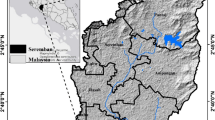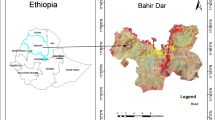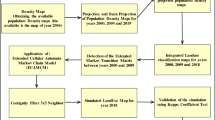Abstract
Predictive modeling and land use/land cover change studies in complex systems are well advanced. Cellular automata (CA)-Markov chain (MC) can be defined as one frequently preferred method for this purpose. This paper aims to adapt the CA-MC model to the simulation of residential areas in the city. The proposed method was tested in the city center of Kastamonu, Türkiye, using four time periods: 1985, 2011, 2015, and 2021. Spatio-temporal change maps were produced using ArcGIS 10.0 software. Land use simulation of the urban center, including residence units for 2031 and 2057, was performed using the integrated CA-MC technique. The method’s suitability was demonstrated with the Kappa index of agreement values (Kstandart: 0.93; Klocation: 0.98; Kno: 0.98; and KlocationStrata: 0.95). Within the scope of the study, two different scenarios were designed as short term (S1) and long term (S2). According to the predictions for 2031, there was a residential area increase of 15% in S1 and 29% in S2. When we reach 2057, these growth values were measured as 50% according to S1 and 72% according to S2.








Similar content being viewed by others
Data availability
The datasets generated during and analyzed during the current study are available from the corresponding author on reasonable request.
References
Aburas MM, Ho YM, Pradhan B, Salleh AH, Alazaiza MY (2021) Spatio-temporal simulation of future urban growth trends using an integrated CA-Markov model. Arabian Journal of Geosciences, 14(2), 1–12. https://link.springer.com/article/10.1007/s12517-021-06487-8
Agyemang FS, Silva E, Fox S (2022) Modelling and simulating ‘informal urbanization’: an integrated agent-based and cellular automata model of urban residential growth in Ghana. Environment and Planning B: Urban Analytics and City Science, 23998083211068843. https://doi.org/10.1177%2F23998083211068843
Ahmed N, Wang G, Lü H, Booij MJ, Marhaento H, Prodhan FA, Ali Imran M (2022) Attribution of changes in streamflow to climate change and land cover change in Yangtze River Source Region China Water 14 2 259. https://doi.org/10.3390/w14020259
Aksoy T, Dabanli A, Cetin M, Senyel Kurkcuoglu MA, Cengiz AE, Cabuk SN, Cabuk A (2022) Evaluation of comparing urban area land use change with Urban Atlas and CORINE data Environ Sci Pollut Res 29 19 28995 29015. https://doi.org/10.1007/s11356-021-17766-y
Amir Siddique M, Wang Y, Xu N, Ullah N, Zeng P (2021) The spatiotemporal implications of urbanization for urban heat islands in Beijing: a predictive approach based on CA–Markov modeling (2004–2050). Remote Sensing 13(22):4697. https://doi.org/10.3390/rs13224697
Babu KA, Prithiv TS, Gupta A, Mandal S (2021) Modeling and simulation of dynamic recrystallization in super austenitic stainless steel employing combined cellular automaton, artificial neural network and finite element method. Comput Mater Sci 195:110482. https://doi.org/10.1016/j.commatsci.2021.110482
Baghestani H (2021) Forecasts of growth in US residential investment: accuracy gains from consumer home-buying attitudes and expectations. Appl Econ 53(32):3744–3758. https://doi.org/10.1080/00036846.2021.1885613
Bindajam AA, Mallick J, Talukdar S, Islam ARM, Alqadhi S (2021) Integration of artificial intelligence–based LULC mapping and prediction for estimating ecosystem services for urban sustainability: past to future perspective. Arab J Geosci 14(18):1–23. https://doi.org/10.1007/s12517-021-08251-4
Booth DB, Karr JR, Schauman S, Konrad CP, Morley SA, Larson MG, Burges SJ (2004) Reviving urban streams: land use, hydrology, biology, and human behavior 1. JAWRA J Am Water Resources Association 40(5):1351–1364. https://doi.org/10.1111/j.1752-1688.2004.tb01591.x
Cetin M, Aksoy T, Cabuk SN, Kurkcuoglu MAS, Cabuk A (2021) Employing remote sensing technique to monitor the influence of newly established universities in creating an urban development process on the respective cities. Land Use Policy 109:105705. https://doi.org/10.1016/j.landusepol.2021.105705
Chaplot V (2021) Evidences of plants’ impact on land degradation and climate change an urgent call for new multidisciplinary research. Geoderma 392:114984. https://doi.org/10.1016/j.geoderma.2021.114984
de Mello K, Taniwaki RH, de Paula FR, Valente RA, Randhir TO, Macedo DR, Hughes RM (2020) Multiscale land use impacts on water quality: assessment, planning, and future perspectives in Brazil J Environ Manage 270 110879. https://doi.org/10.1016/j.jenvman.2020.110879
Dullinger I, Essl F, Moser D, Erb K, Haberl H, Dullinger S (2021) Biodiversity models need to represent land-use intensity more comprehensively. Glob Ecol Biogeogr 30(5):924–932. https://doi.org/10.1111/geb.13289
Esbah H (2007) Land use trends during rapid urbanization of the city of Aydin. Turkey Environ Management 39(4):443–459. https://doi.org/10.1007/s00267-005-0331-y
Feng H, Liu H (2012) Scenario prediction of urban growth based on the SLEUTH model. In Advanced Technology in Teaching-Proceedings of the 2009 3rd International Conference on Teaching and Computational Science (WTCS 2009) (pp. 945–952). Springer, Berlin, Heidelberg. https://link.springer.com/chapter/10.1007/978-3-642-25437-6_126
Garg V, Nikam BR, Thakur PK, Aggarwal SP, Gupta PK, Srivastav SK (2019) Human-induced land use land cover change and its impact on hydrology. HydroResearch 1:48–56. https://doi.org/10.1016/j.hydres.2019.06.001
Genet A (2020) Population growth and land use land cover change scenario in Ethiopia. International J Environmental Protection and Policy 8(4):77–85. https://doi.org/10.11648/j.ijepp.20200804.12
Ghoma WEO, Sevik H, Isinkaralar K (2022) Using indoor plants as biomonitors for detection of toxic metals by tobacco smoke. Air Qual Atmos Health 15(3):415–424. https://doi.org/10.1007/s11869-021-01146-z
Guan DJ, Li HF, Inohae T, Su WC, Nagaie T, Hokao K (2011) Modeling urban land use change by the integration of cellular automaton and Markov model. Ecological Modelling 222:3761–3772. https://doi.org/10.1016/j.ecolmodel.2011.09.009
Hassan T, Zhang J, Prodhan FA, Pangali Sharma TP, Bashir B (2021) Surface urban heat islands dynamics in response to lulc and vegetation across south Asia (2000–2019). Remote Sensing 13(16):3177. https://doi.org/10.3390/rs13163177
Hussein MS (2021) An “out-of-the-depression” drainage solution to the land degradation problem in Siwa Oasis. Egypt Arabian J of Geosciences 14(9):1–15. https://doi.org/10.1007/s12517-021-07100-8
Irwin EG, Bell KP, Geoghegan J (2003) Modeling and managing urban growth at the rural-urban fringe: a parcel-level model of residential land use change. Agricultural and Resource Economics Review 32(1):83–102. https://doi.org/10.1017/S1068280500002525
Ishtiaque A, Shrestha M, Chhetri N (2017) Rapid urban growth in the Kathmandu Valley, Nepal: monitoring land use land cover dynamics of a Himalayan city with Landsat imageries. Environments 4(4):72. https://doi.org/10.3390/environments4040072
Isinkaralar K (2022a) Atmospheric deposition of Pb and Cd in the Cedrus atlantica for environmental biomonitoring Landscape Ecol Eng 1–10. https://doi.org/10.1007/s11355-022-00503-z
Isinkaralar, K (2022b) Temporal Variability of Trace Metal Evidence in Cupressus arizonica Platanus orientalis and Robinia pseudoacacia as Pollution-Resistant Species at an Industrial Site. Water Air & Soil Pollution 233(7) 250 10.1007/s11270-022-05743-1
Isinkaralar K, Koc I, Erdem R, Sevik H (2022) Atmospheric Cd, Cr, and Zn deposition in several landscape plants in Mersin, Türkiye. Water Air Soil Pollut 233(4):1–10. https://doi.org/10.1007/s11270-022-05607-8
Onac AK, Cetin M, Sevik H, Orman P, Karci A, Gonullu Sutcuoglu G (2021) Rethinking the campus transportation network in the scope of ecological design principles: case study of Izmir Katip Çelebi University Çiğli Campus. Environ Sci Pollut Res 28(36):50847–50866. https://doi.org/10.1007/s11356-021-14299-2
Kapović Solomun M, Ferreira CS, Barger NN, Tošić R, Eremija S (2021) Understanding the role of policy frameworks in developing land degradation in stakeholders perception from a post-conflict perspective in Bosnia and Herzegovina. Land Degrad Dev 32(12):3393–3402. https://doi.org/10.1002/ldr.3744
Kilicoglu C, Cetin M, Aricak B, Sevik H (2021) Integrating multicriteria decision-making analysis for a GIS-based settlement area in the district of Atakum, Samsun. Turkey Theoretical and Applied Climatology 143(1):379–388. https://doi.org/10.1007/s00704-020-03439-2
Kindu M, Schneider T, Döllerer M, Teketay D, Knoke T (2018) Scenario modelling of land use/land cover changes in Munessa-Shashemene landscape of the Ethiopian highlands. Sci Total Environ 622:534–546. https://doi.org/10.1016/j.scitotenv.2017.11.338
Kumar A, Pinto MC, Candeias C, Dinis PA (2021) Baseline maps of potentially toxic elements in the soils of Garhwal Himalayas, India: assessment of their eco-environmental and human health risks. Land Degrad Dev 32(14):3856–3869. https://doi.org/10.1002/ldr.3984
Kundu K, Halder P, Mandal JK (2021) Detection and prediction of Sundarban reserve forest using the CA-Markov chain model and remote sensing data. Earth Sci Inf 14(3):1503–1520. https://doi.org/10.1007/s12145-021-00648-9
Kushwaha K, Singh MM, Singh SK, Patel A (2021) Urban growth modeling using earth observation datasets, cellular automata-Markov chain model and urban metrics to measure urban footprints. Remote Sensing Applications: Society and Environment 22:100479. https://doi.org/10.1016/j.rsase.2021.100479
Liu B, Pan L, Qi Y, Guan X, Li J (2021) Land use and land cover change in the Yellow River Basin from 1980 to 2015 and its impact on the ecosystem services. Land 10(10):1080. https://doi.org/10.3390/land10101080
Liu P, Jia S, Han R, Liu Y, Lu X, Zhang H (2020) RS and GIS supported urban LULC and UHI change simulation and assessment J of Sensors 2020. https://doi.org/10.1155/2020/5863164
Liu Y (2018) Introduction to land use and rural sustainability in China. Land Use Policy 74:1–4. https://doi.org/10.1016/j.landusepol.2018.01.032
Mani S, Osborne CP, Cleaver F (2021) Land degradation in South Africa: justice and climate change in tension. People and Nature 3(5):978–989. https://doi.org/10.1002/pan3.10260
Mitsova D, Shuster W, Wang X (2011) A cellular automata model of land cover change to integrate urban growth with open space conservation. Landsc Urban Plan 99(2):141–153. https://doi.org/10.1016/j.landurbplan.2010.10.001
Mondal, M. S., Sharma, N., Garg, P. K., & Kappas, M. (2016). Statistical independence test and validation of CA Markov land use land cover (LULC) prediction results. The Egyp J Remote Sensing and Space Science 19(2), 259–272. https://doi.org/10.1016/j.ejrs.2016.08.001
Rahnama MR (2021) Forecasting land-use changes in Mashhad Metropolitan area using cellular automata and Markov chain model for 2016–2030. Sustain Cities Soc 64:102548. https://doi.org/10.1016/j.scs.2020.102548
Rajaei F, Dahmardeh Behrooz R, Ahmadisharaf E, Galalizadeh S, Dudic B, Spalevic V, Novicevic R (2021) Application of integrated watershed management measures to minimize the land use change impacts. Water 13(15):2039. https://doi.org/10.3390/w13152039
Rimal B, Sharma R, Kunwar R, Keshtkar H, Stork NE, Rijal S, Baral H (2019) Effects of land use and land cover change on ecosystem services in the Koshi River Basin Eastern Nepal Ecosystem Services 38 100963 https://doi.org/10.1016/j.ecoser.2019.100963
Rodríguez-Rodríguez D, Martínez-Vega J (2017) Assessing recent environmental sustainability in the Spanish network of National Parks and their statutory perip heral areas. Appl Geogr 89:22–31. https://doi.org/10.1016/j.apgeog.2017.09.008
Roy PS, Ramachandran RM, Paul O et al (2022) Anthropogenic land use and land cover changes—a review on its environmental consequences and climate change. J Indian Soc Remote Sens. https://doi.org/10.1007/s12524-022-01569-w
Sadeghi B (2021) Concentration-concentration fractal modelling: a novel insight for correlation between variables in response to changes in the underlying controlling geological-geochemical processes. Ore Geol Rev 128:103875. https://doi.org/10.1016/j.oregeorev.2020.103875
Saha TK, Pal S, Sarkar R (2021) Prediction of wetland area and depth using linear regression model and artificial neural network based cellular automata. Eco Inform 62:101272. https://doi.org/10.1016/j.ecoinf.2021.101272
Samie A, Abbas A, Azeem MM, Hamid S, Iqbal MA, Hasan SS, Deng X (2020) Examining the impacts of future land use/land cover changes on climate in Punjab province, Pakistan: implications for environmental sustainability and economic growth. Environ Sci Pollut Res 27(20):25415–25433. https://doi.org/10.1007/s11356-020-08984-x
Sandifer PA, Sutton-Grier AE, Ward BP (2015) Exploring connections among nature, biodiversity, ecosystem services, and human health and well-being: opportunities to enhance health and biodiversity conservation. Ecosyst Serv 12:1–15. https://doi.org/10.1016/j.ecoser.2014.12.007
Seto KC, Shepherd JM (2009) Global urban land-use trends and climate impacts. Current Opinion in Environmental Sustainability 1(1):89–95. https://doi.org/10.1016/j.cosust.2009.07.012
Sharma R, Joshi PK (2015) The changing urban landscape and its impact on local environment in an Indian megacity: the case of Delhi. In Urban Development Challenges, Risks and Resilience in Asian Mega Cities (pp. 61–81). Springer, Tokyo. https://doi.org/10.1007/978-4-431-55043-3_4
Sonu TS, Bhagyanathan A (2022) The impact of upstream land use land cover change on downstream flooding: a case of Kuttanad and Meenachil River Basin, Kerala. India Urban Climate 41:101089. https://doi.org/10.1016/j.uclim.2022.101089
Spruce J, Bolten JD (2018 December) Using MODIS and Landsat data to produce land use land cover maps for the lower Mekong Basin: implications for regional water and disaster management. In AGU Fall Meeting Abstracts (Vol. 2018, pp. GC23C-03).
Sun A (2013) Enabling collaborative decision-making in watershed management using cloud-computing services. Environ Model Softw 41:93–97. https://doi.org/10.1016/j.envsoft.2012.11.008
UN Prospects (2019) Highlights (ST/ESA/SER. A/423): United Nations, Department of Economic and Social Affairs, Population Division (2019). World Population; 2019. https://www.un.org/development/desa/publications/world-population-prospects-2019-highlights.html
Wang J, Maduako IN (2018) Spatio-temporal urban growth dynamics of Lagos Metropolitan Region of Nigeria based on hybrid methods for LULC modeling and prediction. European Journal of Remote Sensing 51(1):251–265. https://doi.org/10.1080/22797254.2017.1419831
Weng L, Qian M, Xia M, Xu Y, Li C (2020) Land use/land cover recognition in arid zone using a multi-dimensional multi-grained residual Forest☆. Comput Geosci 144:104557. https://doi.org/10.1016/j.cageo.2020.104557
Xu C, Rahman M, Haase D, Wu Y, Su M, Pauleit S (2020) Surface runoff in urban areas: the role of residential cover and urban growth form. J Clean Prod 262:121421. https://doi.org/10.1016/j.jclepro.2020.121421
Yilmaz, D., & Isinkaralar, Ö. (2021). Climate action plans under climate-resilient urban policies. Kastamonu University Journal of Engineering and Sciences, 7(2): 140–147.
Zhang H, Qi ZF, Ye XY, Cai YB, Ma WC, Chen MN (2013) Analysis of land use/land cover change, population shift, and their effects on spatiotemporal patterns of urban heat islands in metropolitan Shanghai, China. Appl Geogr 44:121–133. https://doi.org/10.1016/j.apgeog.2013.07.021
Acknowledgements
This study is produced from the dissertation titled “Temporal and Spatial Modeling of Central Business District Development in the Context of Complexity Theory: The Case of Kastamonu,” conducted at Gazi University, Ankara, Türkiye, Graduate School of Natural and Applied Sciences, City and Regional Planning Ph D Programme. We also thank Ilbank I.C., Ankara, for their data support.
Author information
Authors and Affiliations
Corresponding author
Ethics declarations
Conflict of interest
The authors declare no competing interests. All co-authors have seen and agreed with the contents of the manuscript, and there is no financial interest to report. We certify that the submission is original work and is not under review at any other publication.
Rights and permissions
Springer Nature or its licensor holds exclusive rights to this article under a publishing agreement with the author(s) or other rightsholder(s); author self-archiving of the accepted manuscript version of this article is solely governed by the terms of such publishing agreement and applicable law.
About this article
Cite this article
Isinkaralar, O., Varol, C. & Yilmaz, D. Digital mapping and predicting the urban growth: integrating scenarios into cellular automata—Markov chain modeling. Appl Geomat 14, 695–705 (2022). https://doi.org/10.1007/s12518-022-00464-w
Received:
Accepted:
Published:
Issue Date:
DOI: https://doi.org/10.1007/s12518-022-00464-w




